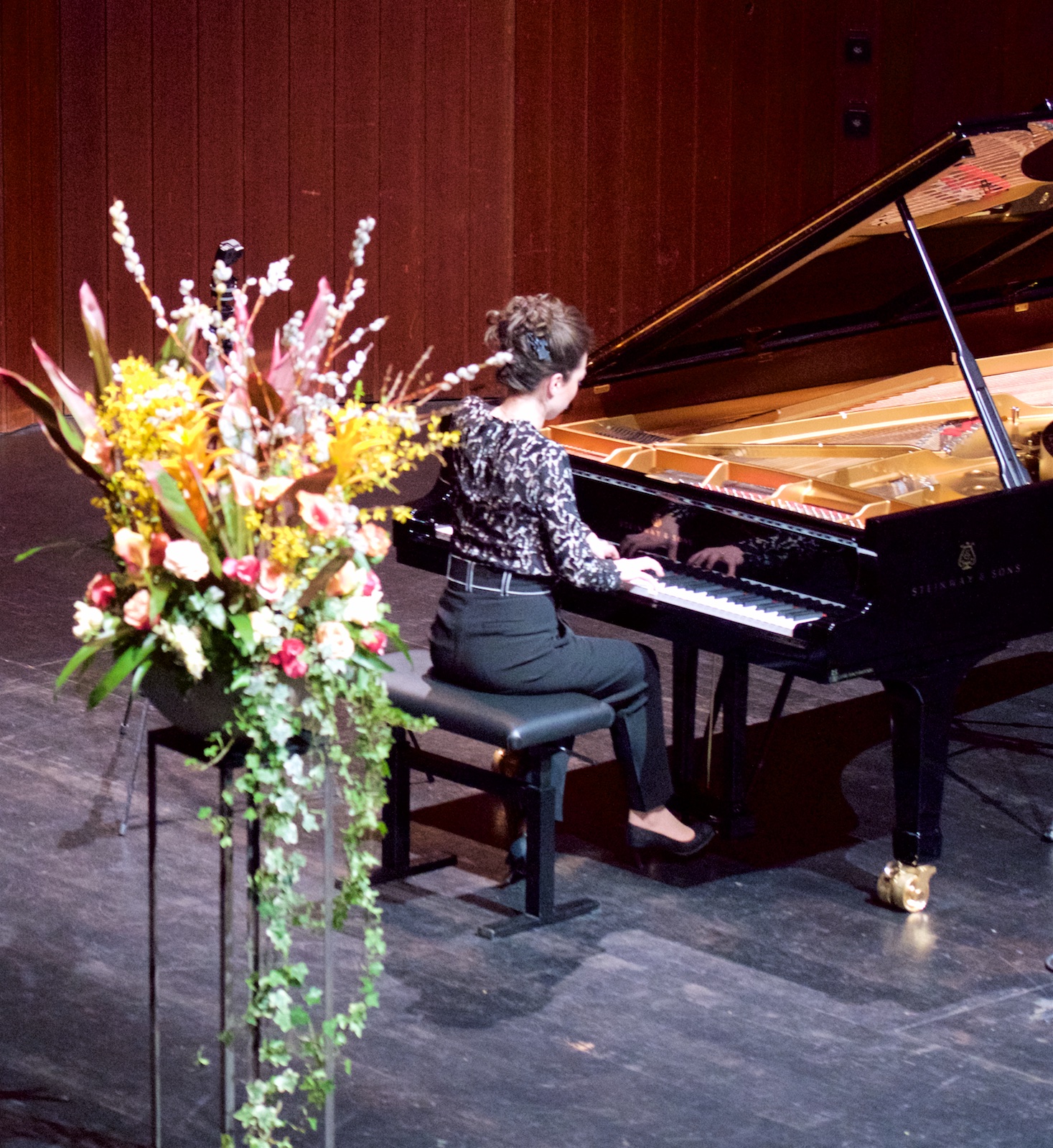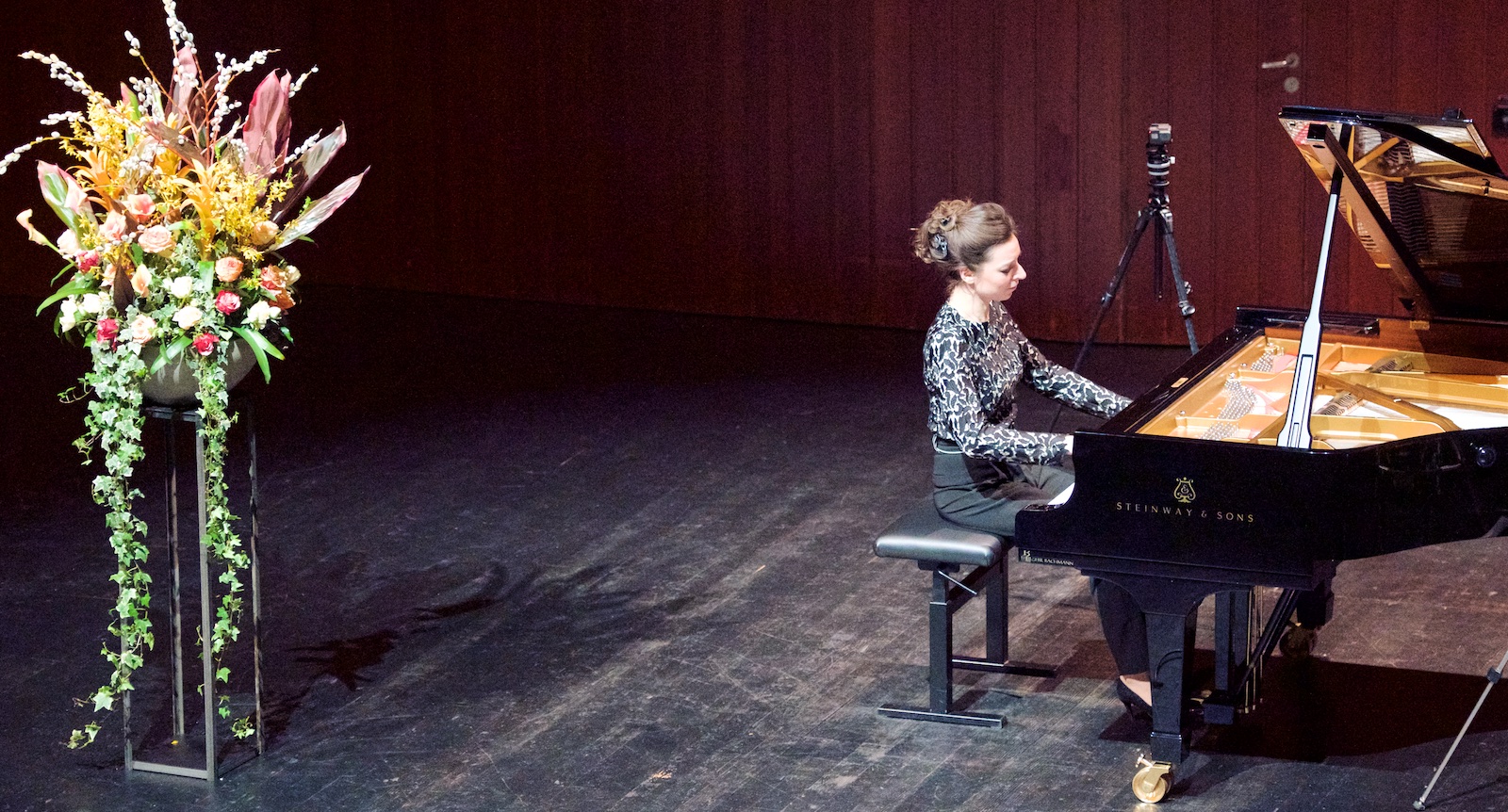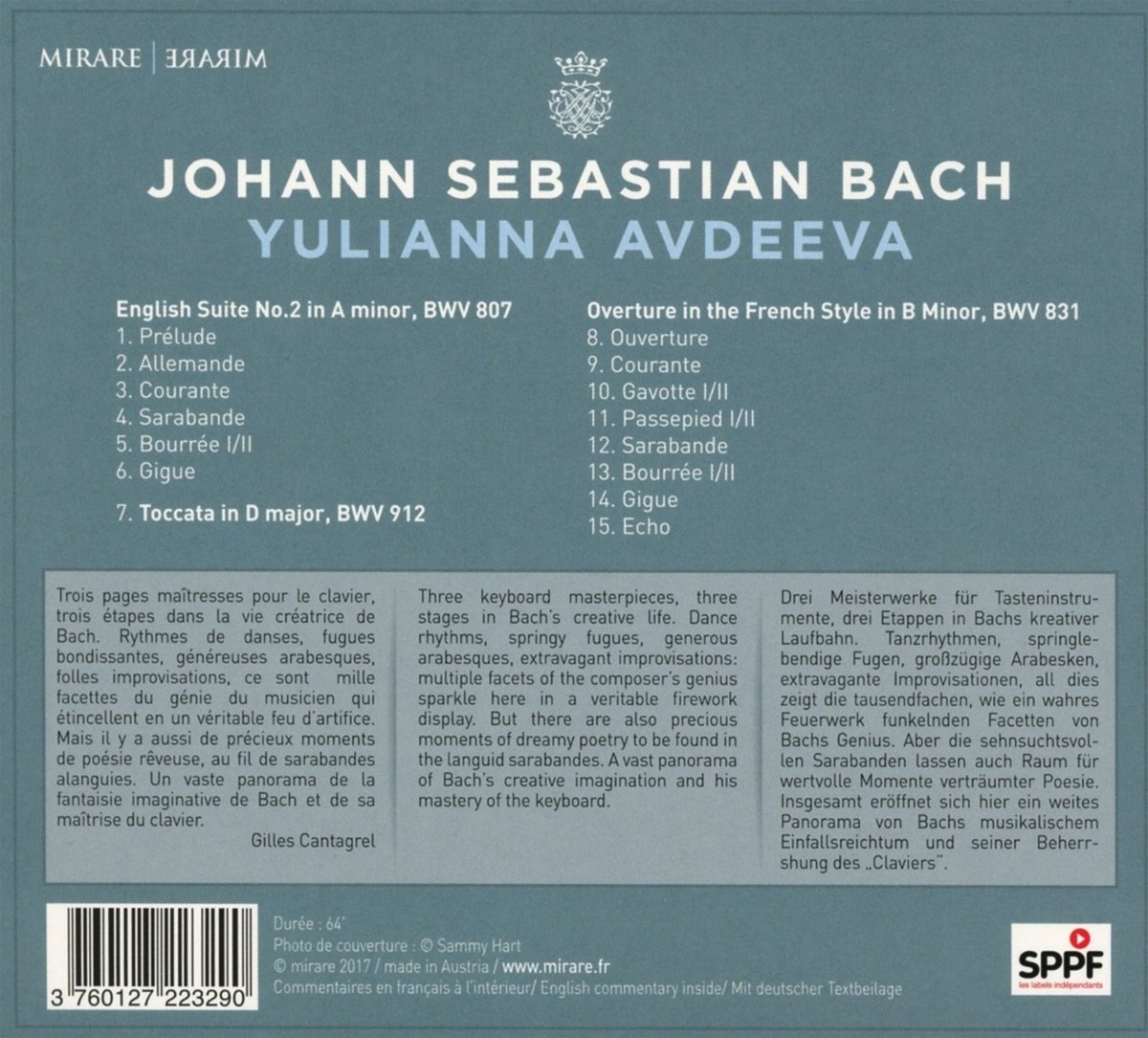Piano Recital: Yulianna Avdeeva
Bach / Chopin
Aula, KZO, Wetzikon, 2018-02-02

2018-02-19 — Original posting

(© 2018 by Rolf Kyburz. All rights reserved)
Ein Einspringer-Rezital von Yulianna Avdeeva am Klavierissimo-Festival 2018 in Wetzikon ZH — Zusammenfassung
Durch die Erkrankung des ursprünglich vorgesehenen Lukáš Vondrácek erhielt die Russin Yulianna Avdeeva kurzfristig die Möglichkeit eines Auftritts in Wetzikon, im Rahmen des Klavierissimo-Festivals 2018. Da kaum Zeit blieb für Vorbereitungen, entschied sich Yulianna Avdeeva, das Programm, welches sie weniger als 10 Monate früher (2017-04-23) in Aarau gegeben hatte, zu wiederholen: Bachs Toccata in D-dur (BWV 912) und die “Französische Ouvertüre” in h-moll (BWV 831). Die Pianistin erwies sich als stilsichere und kompetente Interpreting von Bachs Werken auf dem modernen Flügel—sie hat sich seit ihrer Studienzeit an der ZHdK in Zürich immer mit Bach auseinandergesetzt.l
Im zweiten Teil folgten Werke von Chopin. Dies ist nicht nur ihre Spezialität, sie ist (meines Erachtens) hier seit ihrem Großerfolg am Internationalen Chopin-Wettbewerb in Warschau 2010 ungeschlagen und weltweit an der Spitze. Wie schon in Aarau spielte sie 4 Mazurki aus op.7, danach die Sonate Nr.3 in h-moll, op.58—Meisterinterpretationen, welche das Publikum direkt und unvermittelt ansprachen!
In den Zugaben wich Yulianna Avdeeva allerdings vom jenen in Aarau ab: aus Debussys Estampes die Nr.2, “La soirée dans Granade: Mouvement de Habanera“. Den Abschluss machten danach die beiden Bourées aus Bachs Englischer Suite Nr.2 in a-moll, BWV 807.
Table of Contents
Yulianna Avdeeva, a Surprise Appearance!
Yulianna Avdeeva (*1985, see also Wikipedia) featured in several, if not many of my concert reviews, including my very first blog posts of this type. I have als reviewed some of her CD recordings. Since the days of her big success at the 2010 International Chopin Competition in Warsaw, she is my all-time favorite for Chopin interpretations.
Yulianna Avdeeva’s participation at this year’s “Top Klassik Zürcher Oberland / Klavierissimo” festival in Wetzikon ZH was not programmed. It was the result of the original Lukáš Vondrácek (*1986) falling ill and calling off his participation at short notice. So, just like Oliver Schnyder on 2018-01-31, Yulianna Avdeeva got a chance to step in. Given the above, my wife and I could not resist attending this recital, despite an already crowded schedule.
Obviously, at such short notice, one cannot expect the artist to pull an arbitrary / new program out of their sleeve, and so, Yulianna selected the program that she already played in Aarau on 2017-04-23. For work descriptions and general notes on Yulianna’s performance in these pieces , I therefore refer to that earlier concert review.
Yulianna Avdeeva’s Bach — A Foreword
Yulianna Avdeeva took the last part of her piano education with Konstantin Scherbakov (*1963) at the ZHdK (Zurich University of the Arts). In 2008, she completed her studies with the soloist diploma, and for a while, she remained active at the ZHdK as Konstantin Scherbakov’s assistant.
At the ZHdK, she also met with the harpsichordist and organist Johann Sonnleitner (*1941). That encounter most likely has sparked Yulianna’s interest in Bach’s music. It’s an interest that she kept alive over all the years since, despite her focus on Chopin’s music, which resulted in her splendid victory at the International Chopin Competition in Warsaw, in 2010.
A clear indication for the pianist’s continued interest in Bach’s music is her most recent CD, entirely devoted to Bach, see the bottom of this note. That recording is anything but a “quick shot”. The works on the CD have been on the pianist’s mind for a long time. One can sure take them for mature interpretations. In fact, I checked my records and realized that in the private recital on 2008-11-08, she already played the Toccata in D major, BWV 912, as opening piece. That was my first encounter with the artist—more than nine years ago already!
Concert & Review

Bach: Toccata in D major, BWV 912
This is one of six Toccatas that the young Johann Sebastian Bach (1685 – 1750) around 1708. They can be seen as the “crop”, the result from his trip to Lübeck, from which he returned in 1706. The For an introduction into the composition and a full set of comments on Yulianna’s interpretation see my report from the recital in Aarau on 2017-04-23. Let me just extract a few of my notes from this concert:
Unlike with CD recordings, I can’t simply do a direct comparison with the previous performances. Still, I sense that this performance (as well as the others that followed) were very close to the ones in the previous concert (the first one is to far in the past for me to remember details). The stylus phantasticus in the first and slow segments suite her style of playing very well. Isn’t it somehow related to the way she uses rubato in Chopin?? Her basic tempo in the initial part was fluent, her dynamics as frugal as expected from a historically informed artist (which she certainly is!).
Fugue
The fugue (bar 80ff) appeared mellow—far away from the sound of a harpsichord. However, the artist was nowhere near to exploiting the sound of the Steinway grand. I noted that she diligently used the una corda (soft) pedal. Only in rare instances (such as bars 104ff) she allowed for a moderate crescendo. One can certainly defend that with the argument that the composer did not specify a designated instrument, hence one could think of a clavichord, which indeed does allow for moderate & continuous dynamic variation.
In the final fugue with the triplet theme, Yulianna Avdeeva imitated an instrument with two manuals by using essentially two dynamic levels.

Bach: Partita in B minor, BWV 831 (“Overture in the French Style”)
The Partita in B minor, BWV 831 (“French Overture”), dates from 1735. The movements are
- Ouverture
- Courante
- Gavotte I-II
- Passepied I-II
- Sarabande
- Bourrée I-II
- Gigue
- Echo
Again, for details and general remarks on Yulianna’s performance, I’m referring to the post from the recital in Aarau on 2017-04-23.
The Performance
Ouverture
Traditionally, French overtures assume double punctuation in the opening section. However, Bach already built that into the notation. Yulianna Avdeeva avoided over-punctuation, relying on Bach’s writing, which I think is a) correct, and b) what is doable on a modern grand piano. In the repeat of the opening segment, she discreetely added one or the other extra ornament. In general, I really liked Yulianna’s ornamentation: very much “in style”, as we know and assume to day. Of course, I assume that for someone who has taken lessons with Johann Sonnleitner!
I liked the careful articulation in the fugue part, and the (essentially) two-level dynamics: Bach definitely write this piece for the harpsichord. It was most obvious how much she enjoyed playing Bach: she freed herself from technicalities. The joy of playing dominated. Yet, she kept control: one could tell that however playful the music sounded, every phrase was consciously shaped. At the same time, the interpretation never felt academic or dry. I was most pleased to see that Yulianna also did the second repeat.
Courante — Gavotte I/II — Passepied I/II
The Courante was very singing, melodious. The ornaments in the first passes were slightly “diluted”. That’s adequate for the piano, where not all harpsichord ornaments can be adopted in a 1:1 fashion.
The Gavotte I was nicely dancing, with extra, suitable ornaments in the repeats. The Gavotte II followed a tad slower, mellow and soft—p, as Bach specified. I most enjoyed the agogics—like those hinted ritenuti in front of key notes!
The Passepieds were again fluent—yet, with nice agogics, such as the little ritenuto on the second note in the initial motif. The second Passepied was in a similar tempo, but contrasted with a soft, mellow tone. I liked the inégal playing / ornament in the second pass of the last bars.
Sarabande — Bourrée I/II — Gigue — Echo
Compared to a typical harpsichord performance, the tempo in theSarabande appeared fairly fluent, albeit still appropriate for that dance movement at Bach’s time. The first passes again slightly diluted in the ornaments, but in contrast additional accidentals in the second passes. I liked the subtle staccato variation in the articulation during the repeat of the second part, and the “improvisation feeling” with the arpeggi towards the end.
Very conscious, careful and detailed articulation and agogics in the Bourrée I, playful in the ornaments. The Bourrée II was again marvelously mellow and soft. However I never had the impression of excess sustain pedal usage.
The Gigue: philandering, swinging / swaying, also in Yulianna’s body language, playful and humorous in the best sense of the words!
The closing Echo movement imitates the echo with the two contrasting manuals / stops of the harpsichord. Imitating this on the piano, but requires dynamic discipline, in order not to appear exaggerated: not a challenge for Yulianna Avdeeva, needless to say!
Conclusion
Yes, I remain skeptical about baroque music on the modern concert grand. A key part of that skepticism stems from a lack of color differentiation between the various tonalities on instruments (such as a concert grand) with equal temperament tuning. However, unlike Bach’s Well-tempered Clavier, the pieces that Yulianna played are close enough to C, F, or G major for the color differences between the keys to play a minor, if not negligible role.
Yulianna won’t make me a fan of baroque music on a Steinway grand. However, among the Bach performances on modern instruments, this is one that I can sincerely defend!

Chopin: 4 Mazurki from op.7
Among the many different types of piano pieces that Frédéric Chopin (1810 – 1949) has written, the Mazurki (plural of Mazurka) are the most personal ones, the “most Polish” compositions that he wrote. Along with the Polonaises, of course. As already in the recital in Aarau on 2017-04-23, Yulianna selected four of the Mazurki from op.7 (composed 1832):
- B♭ major (Mazurka No.5): Vivace (3/4, 3/4 = 50)
- A minor (Mazurka No.6): Vivo, ma non troppo (3/4, 1/4 = 160)
- F minor ((Mazurka No.7): (3/4, 3/4 = 54)
- A♭ major (Mazurka No.8): Presto, ma non troppo (3/4, 3/4 = 76)
- C major (Mazurka No.9): Vivo (3/4, 3/4 = 60)
The Performance
What new can I say about Yulianna’s Chopin? She is and remains my all-time favorite pianist for this composer—extraordinary and unique in so many ways! It does not sound foreign to me, at all. However, in a way, she makes most other pianists sound more neutral, if not (almost) boring! She is the first pianist I know really to break off from the crowd, the mold. Yet, she does so (in my view) without unnecessary extravaganza. Many may disagree with me on that last point. But, as I see it, her Chopin is truly sincere, heartfelt—and properly, thoroughly researched, in everything she plays from this composer.
Mazurka in B♭ major
With the first bars, the artist knew how to evoke the special atmosphere in these pieces: that folk dance spirit with almost extreme rubato! It’s rubato in the proper sense: where she stretches out time in the swing of a dance movement, she instantly compensates, catches up again in the following bars—
Mazurka in A minor
Here, Yulianna starts out of almost no movement on the first three notes, then picks up momentum, swaying forth and back. The central dolce part is a little window of happiness initially, then becoming more dramatic, before the melancholy of the initial segment returns. Very, extremely atmospheric!
Mazurka in F minor
The initial sotto voce bars in the left hand seem almost menacing, before the con anima, later con forza and rubato (all in the score, of course) takes over. One should keep in mind that Chopin’s score specifies pretty much all of the rubato, the stretto, fermata, a tempo, annotations. These are the composer’s intent, not the pianist’s extravaganza!
Mazurka in A♭ major
Yulianna ends the set with the Mazurka in A♭ major, omitting the Mazurka No.9 in C major. This may be based on manuscript studies (I’m sure the pianist has done the necessary, thorough research). In any case, in her hands, the A♭ major piece is short, joking, lively enough (the shortest of the four), such that the even shorter, if not minuscule C major Mazurka can’t add much, might even sound a bit ordinary: the A♭ major indeed makes up for the better ending.
I wonder whether Yulianna Avdeeva will ever record the entire set of Chopin’s Mazurki?

Chopin: Piano Sonata No.3 in B minor, op.58
Chopin’s Piano Sonata No.3 in B minor, op.58 is from 1844. It’s the somewhat less popular, less extroverted, maybe less brilliant of the composer’s three sonatas (or rather two that are regularly performed in concert). At the beginning of her career, Yulianna focused on the Sonata No.2 in B♭ minor, op.35, which she also played at the Chopin Competition in 2010. Years passed by before she started playing the Sonata No.3 in concert. As all other pieces in the program, she also presented this sonata in Aarau last year. The four movements are as follows:
- Allegro maestoso
- Scherzo: Molto vivace
- Largo
- Finale: Presto, ma non tanto
And again, for detailed comments on the piece, as well as on Yulianna’s interpretation see the review on the recital in Aarau on 2017-04-23.
The Performance
Yulianna just briefly took the vivid applause, then sat down again for the sonata. I will just mention a few key observations, rather than repeating what I already stated in my previous report.
I. Allegro maestoso
The fundamental characteristics of Yulianna’s interpretation haven’t changed that much over the past year. Still, I felt that she has progressed yet another step, was now playing more freely, above all technicalities of Chopin’s challenging score. Yulianna clearly was enjoying her own mastership—and of course the music! She seemed totally immersed in the playing, living the music, really. While she did not appear to take notice of the audience, she clearly kept the oversight over the score, formed, shaped the big phrases, the dramatic expression that unfolds in this movement. She appeared to control her hands and fingers with complete independence—not just with those dramatic, ascending chromatic scales, but throughout the movement, the sonata.
There wasn’t a dead moment in the entire, long movement. Yulianna kept up the tension, kept “telling the big story” in this music, highlighted the beautiful, singing melodies: wonderful, enthralling!
II. Scherzo: Molto vivace
Ghastly initially, yet playful—and virtuosic in a very natural, unspectacular way: not a show, just expression. The central part wonderfully lyrical, initially like distant memories, temporarily turning more serious, building up drama again, returning to serenity, before the Scherzo fireworks return.
III. Largo
The Largo followed attacca, with its dramatic, punctuated beginning. This quickly mutates into a calm, serene atmosphere with endless, longing, melancholic melodies, forming big, harmonious arches, waves of emerging emotion: very touching, indeed! It’s one single, long elegy, with only one short, more earnest episode, where the tonality temporarily modulates from E major to F minor.
IV. Finale: Presto, ma non tanto
Also this movement followed without interruption, rapidly building up volume, up to the agitato in bar 9, with its turmoil of emotions and drama. And again, nothing as mere show: virtuosity was nothing more than a necessary ingredient, the basis for all the expression, the dramatic course of action, enthralling throughout the movement.
A masterful interpretation that grabbed the listener by the neck, left the audience in total awe!

Yulianna Avdeeva’s Encores
The one segment where Yulianna’s program differed from that in Aarau on 2017-04-23 is with the encores. In Aarau, she selected a Mazurka from Chopin’s op.17, and she concluded with another, piece by Chopin, the famous “Heroic” Polonaise in A♭ major, op.53. The encores in this recital could not have been more different:
Debussy — Estampes, L.100, 2. La soirée dans Granade
I have heard Yulianna play numerous pieces that were composed in France (Chopin, Liszt). But never so far, I have heard her venture into the “properly” French expressionist repertoire. I was ever so pleased to hear her play a composition by Claude Debussy (1862 – 1918), namely from his Estampes, L.100, the second piece, labeled “La soirée dans Granade: Mouvement de Habanera“. It’s an enchanting, very atmospheric composition, gently swaying, “suspended” in its mood—really well-played, and amazingly fitting well after the big gestures in the Chopin sonata!

Bach — English Suite No.2 in A minor, BWV 807: 5. Bourrée I & II
For the final conclusion, however, Yulianna returned to a movement from her recent Bach recording (see below): from the English Suite No.2 in A minor, BWV 807 the fifth movement, a pair of Bourrées. Hereby, she closed the circle to the beginning of the concert, with a playful, lively piece, surrounding a more lyrical, mellow Bourrée II. As the applause proved, this was most appreciated by the audience. Actually, everybody I spoke to was most impressed by Yulianna’s performance that evening, and moved by the music she played.

Yulianna Avdeeva’s Latest CD Recording
Bach: English Suite No.2 in A minor, BWV 807; Overture in the French Style in B minor, BWV 813; Toccata in D major, BWV 912
Yulianna Avdeeva, piano
mirare MIR 329 (CD, stereo); © 2017; booklet: fr/en/de

A Note on the Photos
All photos in this posting (excepting the CD images, obviously) are my own (© 2018 by Rolf Kyburz. All rights reserved). The photographs and GIFs, or any part or portion thereof, may not be reproduced, used, distributed, or transmitted in any form or by any means without the prior written permission of the author. For permission requests, contact the author.
Let me add a few remarks here:
- I happened to take over 350 pictures (didn’t count while shooting!).
- Of these, I evaluated some 260 as being “usable”. That’s of course too many to post individually, and equally too time-consuming to discriminate “fair” vs. “acceptable”.
- Sadly, I did not bring along a tripod: this was one of the first concerts with the new photo gear. So I ended up straightening and cropping every single shot individually.
- I decided to combine sets of related images into 6 animated GIFs using a selection of around 100 pictures. The manual and individual straightening etc. led to variations in the cropping, hence the imperfect size matching & the jumping in the GIFs.
- Upon request, I may make individual shots available at higher resolution (use the Contact form, and please try being specific about which shots exactly you would like).
- Note that the pixel count on the originals is huge, so I’m unlikely to make pics available in full resolution. Anyway, the images are quite “grainy” / noisy, as the lighting was sub-optimal. I was shooting free-handedly from the last row in the back of the audience. So don’t expect miracles at higher resolution.
Technical Information
- Camera: Nikon D850
- Lens: AF-S Nikkor 70.0 – 200.0 mm 1:2.8GII ED / VRII
- Settings:
- all shots @ f/2.8
- focal length 75 – 135 mm
- shutter speed 1/80 – 1/160 s
- ISO 5000 – 20000
The animated GIFs were created using the free tool at gifmaker.me, after resizing the individual shots to 1024 pixels (vertically). The EXIF and IPTC picture information is lost in this process, unfortunately.





